After another visit to Burney Falls to see it in the morning light and a good breakfast, I head north up 89
again, destination Medicine Lake, two hours away. Logging trucks are the predominant traffic. Shortly after turning
off on to the forest roads that lead to the lake, I encounter a loaded one coming flying head-on around a blind
curve straddling the center line. The lurch his trailer takes as he jerks over into his lane scares me more than
trying to find a place to dive off the shoulder. I am wide awake the rest of the way to Medicine Lake.
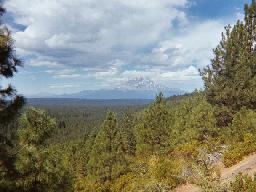 |
I see Shasta from so many places on the journey. On Lassen Peak, the camera just doesn't capture it, but the eye
sure does. I stop along Forest Road 15 at a nice point to let some of the adrenaline drain off, and get this shot.
Not much snow on her these days. Those clouds are building up. What is it about volcanoes? For me, it is a connection
to the raw Power of Nature on this planet we live on. As this is written, one of the other Cascade Range volcanoes,
Mount Saint Helens, is acting up. Medicine Mountain, where I am going is the largest by volume of all of
the Cascades. |
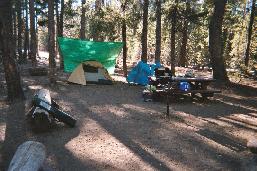 |
Arriving in the late morning, I cruise around the lake, scoping out the beach and the four nearly-empty campgrounds.
I come across Ranger Donna and her rangerette helper, cutting deadfall and stacking it up for firewood. We're in
a dense lodgepole pine forest, and there are so many downed trees that they supply free firewood all over the camps.
I ask Ranger Donna about the weather, and she says she hasn't heard anything from the forest service. I select
a campsite as it starts to rain. Note tarp over tent and bicycle. It doesn't rain again, of course. |
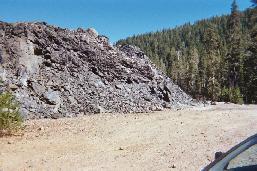 |
Having hiked Lassen Peak and the Burney Falls trail the day before, I go looking for a less taxing adventure after
lunch. Glass Mountain is one of the two youngest lava flows on Medicine Mountain. Estimates of its age range from
200 to 1000 years old, with most favoring the latter. It is over 4800 acres of obsidian, two different kinds, that
flowed out without mixing. That would be about eight square miles. |
|
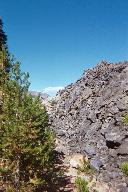
|
One of the most striking things, to me at least, about this and other lava flows I see, is the abruptness of their
edges. This stuff was somewhat viscuous as it flowed, so it shouldn't be surprising, but how often do you see a
lava flow that is only 1000 years old? This is a lot of busted up rocks; as soon as the lava starts to cool, it
starts to fracture, and over the years, the snow and ice mantle does the rest. |
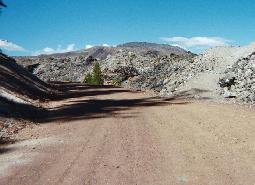 |
A few miles away, there is a cone or dome in the midst of this rock pile. By the edge of the path going up on the
right, you can clearly see one very large chunk of black glass. |
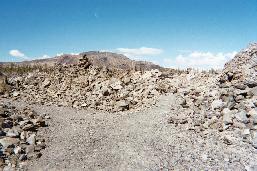 |
After seeing it from up on top of the flow, I describe this as looking at "the slag heaps of the forges of
Hell" in my journal. The camera picks up more of the reflections off the obsidian - there is a lot of black
glassy rock here. To say the least, this place is a wonder. |




